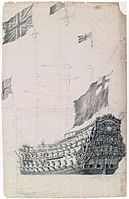London (ship, 1656)
|
Rear view of the London, circa 1660
|
||||||||||||||
|
||||||||||||||
|
||||||||||||||
|
||||||||||||||
|
||||||||||||||

The London was a three-decker with 64 guns of the Royal Navy . It was lost on March 8, 1665 in an explosion in the Thames Estuary. After the wreck was found in 2008, it was immediately placed under protection. Even so, three guns were illegally sold to the United States . The person responsible for the recovery was sentenced to two years in prison and a sentence of ₤ 35,000 .
The ship
After the Naseby was built in 1655, two somewhat smaller three-deckers were commissioned. The Dunbar (from 1660 Henry ) was built by Manley Callis in Deptford and the London by Captain John Taylor in Chatham . Originally designed for 64 guns, the Dunbar was rebuilt so that 80 guns could also be positioned. In return, both ships did not have a forecastle . In 1660 the London still had 64 guns on board.
From launch to sinking
The first known mission was to represent the interests of the English crown in the Baltic Sea during the Second Northern War . After Denmark asked the Netherlands for help and the Netherlands saw their trade interests in the Baltic Sea threatened by the Swedes, they actively intervened in this war. In the sea battle in the Oresund , the Dutch fleet ended the Swedish blockade of the Danish capital . The British saw themselves disadvantaged by the victory of the Dutch, especially since a sea war had just been fought and there was still a lot of mistrust. So the Commonwealth sent a fleet to observe in the Baltic Sea. This also included the London under Rear Admiral Richard Stayner with 64 guns and a crew of about 400. But there were no combat missions and with the death of Cromwell , the fleet was recalled.
The next known mission was the transfer of the exiled king from the Netherlands back to England. After a new English parliament loyal to the king was appointed, Charles II was offered the crown. Therefore, a squadron of the English fleet picked him up from Scheveningen in May 1660 . The London had the future King James II on board for this crossing . He was the younger brother of Charles II and during the Second and Third Naval Wars against the Netherlands, Commander-in-Chief of the Fleet and Lord High Admiral .
With the beginning of the Second Sea War against the Netherlands in 1665, the fleet was concentrated in the spring. The London should be the ship of Vice Admiral Sir John Lawson of the red flag. To take the Admiral on board, the London sailed up the Thames. The cannons were ready or made ready to salute the Admiral. The ship exploded, probably due to an error loading the cannons. Of the more than 300 people on board, only 25 survived, some seriously injured, including one woman.
The wreck
The first indication of a wreck came in 1962 when a gun barrel was found. But it wasn't until 2008 that the wreck site was placed under protection. During an archaeological investigation campaign in 2014 and 2015, numerous objects were recovered for investigation. However, five gun barrels have already been recovered. Two pipes went to the Royal Armories in Portsmouth and three were privately salvaged and sold to the US. The person responsible, a private entrepreneur, was therefore sentenced to two years' imprisonment and 35,000 ₤.
literature
- Frank Fox: Great Ships. The Battlefleet of King Charles II. Conway Maritime Press, Greenwich 1980, ISBN 0-85177-166-1 .
- Brian Lavery: The Ship of the Line. Volume 1: The development of the battlefleet, 1650-1850. Conway Maritime Press, London 2003, ISBN 0-85177-252-8 .
Web links
- Entry in the British monument database "Historic England" ( Memento from September 6, 2015 in the Internet Archive )
- BBC news of August 12, 2015 ( Memento of August 14, 2015 in the Internet Archive )
- News at Divernet ( Memento from September 6, 2015 in the Internet Archive )
- Biography of London ( Memento from June 13, 2015 on the Internet Archive )
- Decree on the protection of the wreck site ( Memento from September 6, 2015 in the Internet Archive )
Coordinates: 51 ° 29 ′ 0 ″ N , 0 ° 44 ′ 0 ″ E

